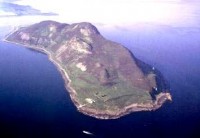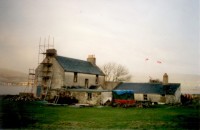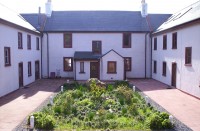Recent History
 In the early 1980s, Lama Yeshe Rinpoche was practising dream yoga during a retreat in the United States, and in his dream he visited an island.
In the early 1980s, Lama Yeshe Rinpoche was practising dream yoga during a retreat in the United States, and in his dream he visited an island.
Although he had never seen or heard of this island before, in his dream he felt that this was a place where human beings and all life forms could live in harmony; a place that would nurture understanding and trust between people of different beliefs and faiths.
Finding Holy Isle
It was not until 1990 that Lama Yeshe was approached by Mrs Kay Morris, who owned Holy Isle together with her husband. Mrs Morris, a devout Catholic, had been instructed by Mother Mary in a dream to pass Holy Isle to him, to be used for peace and meditation. However, the asking price was an impossible sum for Lama Yeshe to raise. Nevertheless he made his first visit to Holy Isle on the winter solstice day of 1990, together with a few students and Mrs Morris' son. They explored the island, and when night fell, Lama Yeshe saw the twinkling lights on the shores on the other side. This reminded him of the island he had seen during the dream yoga so many years before. Additionally, he had felt an instant affinity for the island's rugged terrain. He felt inspired and confident to reawaken the island's sacred past and develop it as a place of retreat where peace would be easy to find, not only for Buddhists, but for people of all faiths.
In spite of the lack of funds, Lama Yeshe's vision for Holy Isle was so strong that he was able to fire the imagination of others. After a massive fundraising effort and generous donations from thousands of people from all over the world, the island was signed over on the 18th of April 1992.
Renovation and conservation
 After the overwhelming generosity of so many people that enabled the buying of the island, the real work was now to begin. The buildings both at the north and the south end had been uninhabited for years and were in a semi-derelict state, having suffered from wind, rain, dry-rot and vandalism - so the first step was to renovate them. A few dedicated resident volunteers, together with many volunteering guests, restored the lighthouse cottages at the south end. In November 1995 the first one year retreat was able to begin there.
After the overwhelming generosity of so many people that enabled the buying of the island, the real work was now to begin. The buildings both at the north and the south end had been uninhabited for years and were in a semi-derelict state, having suffered from wind, rain, dry-rot and vandalism - so the first step was to renovate them. A few dedicated resident volunteers, together with many volunteering guests, restored the lighthouse cottages at the south end. In November 1995 the first one year retreat was able to begin there.
A plan for nature conservation was drawn up by experts from the Nature Conservancy Council in collaboration with the Scottish Wildlife Trust. A start was made with the planting of thousands of indigenous trees. The tree areas were fenced off so that they would be safe from the animals. Measures of controlling the bracken to create more grazing grounds, and eradicating the invasive rhododendrons began.
The Centre for World Peace and Health
 In 1996 planning permission for the Centre for World Peace and Health was granted. Lama Yeshe decided to build the Centre so that it would incorporate the existing farmhouse, despite the extra efforts and costs involved. The renovation of the farmhouse was done entirely by volunteers and took several years to complete, and in 2001 the first visitors were able to stay in the comfortable guests rooms. Two wings containing guest rooms and a spacious dining room rose on either side of the farmhouse leaving a courtyard in the middle, enclosed on the fourth si
In 1996 planning permission for the Centre for World Peace and Health was granted. Lama Yeshe decided to build the Centre so that it would incorporate the existing farmhouse, despite the extra efforts and costs involved. The renovation of the farmhouse was done entirely by volunteers and took several years to complete, and in 2001 the first visitors were able to stay in the comfortable guests rooms. Two wings containing guest rooms and a spacious dining room rose on either side of the farmhouse leaving a courtyard in the middle, enclosed on the fourth si de by the Peace Hall to host courses, workshops and conferences. In the building of the Centre, ecologically sound materials and methods, non-toxic and bio-degradable paint, and environmentally friendly insulation materials were used wherever possible.
de by the Peace Hall to host courses, workshops and conferences. In the building of the Centre, ecologically sound materials and methods, non-toxic and bio-degradable paint, and environmentally friendly insulation materials were used wherever possible.
On the 31st of May 2003 the Centre officially opened its doors to the public. After repeated requests for a space to do quiet retreats over winter, the Centre kept its doors open to individuals in the winter for the first time in 2005.
